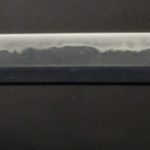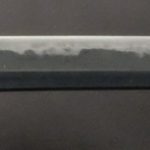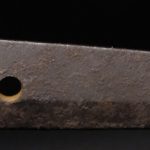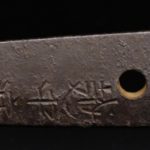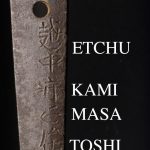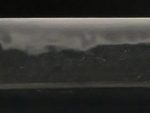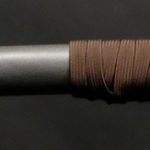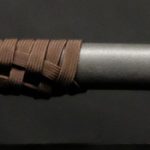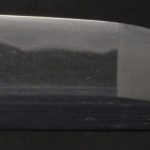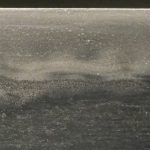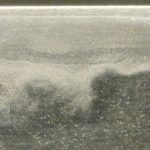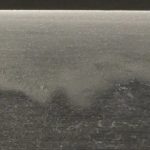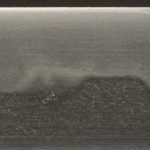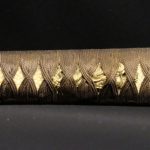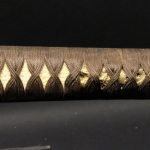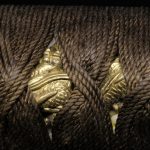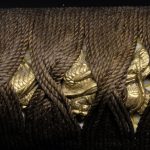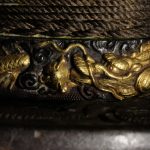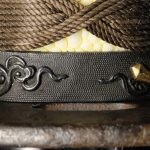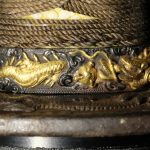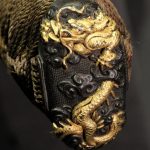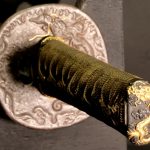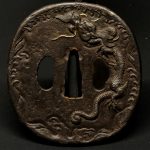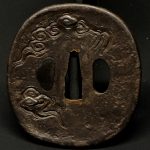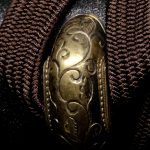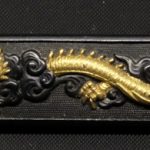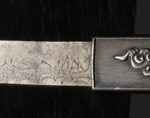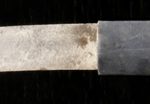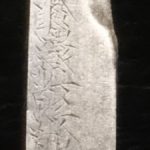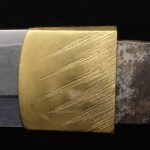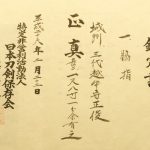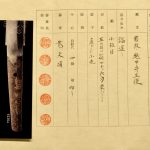ETCHU NO KAMI MASATOSHI / DRAGON KOSHIRAE
MASATOSHI
ETCHU NO KAMI
SANDAI
WAKIZASHI IN DRAGON KOSHIRAE
NTHK KANTEISHO
CHUJO-SAKU
SUGATA: SZ
MEI: (KIKU) ETCHU no KAMI MASATOSHI
DATE: NONE c. 1684-1688
NAGASA: 21.625″
OVERALL: 27″
MIHABA: 1.25″
KASANE: 0.25″
SORI: 0.5”
NAKAGO: UBU
MEKUGI ANA: ONE
YASURIME: KIRI
MUNE: IORI
HADA: ITAME
HAMON: GUNOME MIDARE
BOSHI: MIDARE KOMI
HORIMONO OMOTE: NONE
HORIMONO URA: NONE
HABAKI: 1 PC.
KOSHIRAE
This long wakizashi is attributed to the third generation (Sandai) Etchu no Kami Masatoshi. There were four generations of this Yamashiro Masatoshi group. There is said to be few extant works known by this smith. He inscribed a 16 petal kikumon on the nakago of his works.
The koshirae features a black Ishime saya with horn koiguchi and a gold plated kurigata with a karakusa design. All fittings except the kurigata are of dragons, see photos. A very nice package with ensuite koshirae and NTHK papers.
HISTORY
Courtesy of Sesko’s, Swordsmiths A-Z:
MASATOSHI (正俊), 1st gen., Keichō (慶長, 1596-1615), Yamashiro – “Heianjō-jū Masatoshi” (平安城住正俊),
“Etchū no Kami Masatoshi” (越中守正俊), “Etchū no Kami Fujiwara Masatoshi” (越中守藤原正俊), he was the fourth son of the Eiroku-era (永禄, 1558-1570) Kanemichi (兼道) and accompanied his father in the second month of the second year of Bunroku (1593) to Kyōto where they settled in the Nishinotō´in (西洞院) district and where his father founded the Mishina school (三品), he received the honorary title Etchū no Kami on the twelfth day of the ninth month Keichō two (1597), we know date signatures from the fifth year of Keichō (1600) to the sixth year of Kan´ei (寛永, 1629), katana are rather rare, most extant works are hira-zukuri ko-wakizashi and tantō, he was one of the best Mishina smiths and well versed in all of the gokaden as well as in the shintō-tokuden, the jigane looks hard and the jihada is an itame mixed with masame, whereas the latter appears noticeably towards the mune, the hamon is a nie-laden ō-midare or ō-notare mixed with togariba, sunagashi and kinsuji, some interpretations remind of Shizu (志津), works in the Yamashiro tradition show a dense ko-itame mixed with masame, the hamon is then a chū-suguha-hotsure with uchinoke and hakikake, the bōshi is a Mishina-bōshi, the yasurime are sujikai, rarely also kiri or katte-sagari, he signed with a peculiar, rather playful manner, wazamomo, jōjō-saku.
MASATOSHI (正俊), 2nd gen., Shōhō (正保, 1644-1648), Yamashiro – “Etchū no Kami Masatoshi” (越中守正俊), “Etchū no Kami Fujiwara Masatoshi” (越中守藤原正俊), he carved from the Shōhō era onwards a 16-petalled chrysanthemum onto his tangs which looks like a paddle wheel, we know date signatures from the second year of Shōhō (1645) to the sixth year of Enpō (延宝, 1678), chūjō-saku.
*MASATOSHI (正俊), 3rd gen., Jōkyō (貞享, 1684-1688), Yamashiro – “Etchū no Kami Masatoshi” (越中守正俊), first name Tōshirō (藤四郎), he too carved a chrysanthemum onto his tangs, only few works are known by the 3rd gen. Masatoshi, chūjō-saku
Courtesy of Fujishiros:
Page 302
MASATOSHI ETCHÛ NO KAMI SHODAI [GENNA 1615 YAMASHIRO] SHINTÔ JÔJÔSAKU
He is the fourth son of Seki Kanemichi, and along with his three older brothers, Kanemichi, Yoshimichi and Rai Kanemichi, he went up to Kyoto and lived in Nishi no Tôin Ebisugawa. He is said to have received the title of Etchû no Kami in Keichô Ninen (1597) Kugatsu, and produced till around Kan’ei. The swords he made have a wide body, ji is moku itame, and hamon is sugu midare or notare midare with sunanagashi and togari ha majiri. Even though there is a story in the Shintô Bengi which says “As for Masatoshi, those with HEIANJÔ JÛ FUJIWARA MASATOSHI are the shodai, and Etchû no Kami was inscribed later,” the Heianjô Masatoshi commonly referred to is a separate person in the Ishidô Ha. (Wazamono)
Page 303
MASATOSHI ETCHÛ NO KAMI NIDAI [SHÔHÔ 1644 YAMASHIRO] SHINTÔ CHÛJÔSAKU
He received the title of Etchû no Kami during the Kan’ei era, and he inscribed his mei with a file in the same manner as did the shodai in his twilight years. He inscribed the KIKU MON around Shôhô, his style generally resembles the shodai, and there are also some with ordinary suguba. (Wazamono)
Page 304
*MASATOSHI ETCHÛ NO KAMI SANDAI [TENNA 1681 YAMASHIRO] SHINTÔ CHÛJÔSAKU
He is called Tôsaburô, and like his father, he inscribed the KIKU MON.
Signatures: ETCHÛ NO KAMI MASATOSHI
He inscribed the KIKU MON.
SOLD
